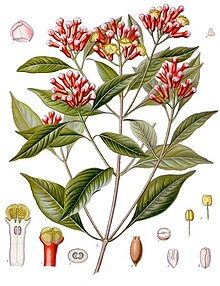**Etymology and Description**:
– The word ‘clove’ originated in the 15th century from Middle English, Anglo-French, and Old French, deriving from the Latin word ‘clavus’ meaning nail.
– The related term ‘gillyflower’ initially referred to cloves, originating from Old French and Latin.
– The clove tree is an evergreen that grows up to 8–12 meters tall with large leaves and crimson flowers in terminal clusters.
– Clove flower buds transition from pale to green and then bright red when ready for harvest, typically at 1.5–2 centimeters long.
– Clove stalks are slender stems with opposite decussate branching.
**Culinary and Non-Culinary Uses**:
– Cloves are prevalent in Asian, African, Mediterranean, and Middle Eastern cuisines, flavoring meats, curries, marinades, and fruits like apples and pears.
– They are common in spice blends like pumpkin pie spice and pair well with cinnamon, allspice, and vanilla.
– In non-culinary uses, cloves enhance aroma in betel quids, kretek cigarettes, wood preservation, and fragrant pomanders.
– Clove essential oil inhibits mold growth on foods and is used in various products such as clove cigarettes.
**Medicinal Uses and Phytochemicals**:
– Clove oil is known for its analgesic properties, particularly in dental emergencies and toothache pain.
– It is effective against Enterococcus faecalis bacteria and contains phytochemicals like eugenol, acetyl eugenol, beta-caryophyllene, vanillin, and tannins.
– Eugenol, constituting 72–90% of clove essential oil, is responsible for the characteristic aroma of cloves.
– Extraction methods like pressurized hot water, ultrasound-assisted, and microwave-assisted techniques are used to extract phytochemicals efficiently.
**Research and Studies**:
– Research has shown that cinnamon and clove essential oils inhibit mold growth on baked foods and are evaluated for antifungal wood protection.
– Studies on clove’s efficacy in dry socket management, against Enterococcus faecalis, and in various applications are ongoing.
– Various research articles, journals, and authors explore the nutraceutical perspectives and extraction techniques related to clove phytochemicals.
**References and Publication Information**:
– References to sources like the Germplasm Resources Information Network, Oxford English Dictionary, and additional sources like Kew Science, Drugs.com, and Tridge provide further information on clove.
– Publication information includes research papers, scientific journals, authors, and toxicology evaluations related to clove and its components.
Cloves are the aromatic flower buds of a tree in the family Myrtaceae, Syzygium aromaticum (/sɪˈzɪdʒiːəm ˌærəˈmætɪkəm/). They are native to the Maluku Islands, or Moluccas, in Indonesia, and are commonly used as a spice, flavoring, or fragrance in consumer products, such as toothpaste, soaps, or cosmetics. Cloves are available throughout the year owing to different harvest seasons across various countries.
| Clove | |
|---|---|

| |
| Scientific classification | |
| Kingdom: | Plantae |
| Clade: | Tracheophytes |
| Clade: | Angiosperms |
| Clade: | Eudicots |
| Clade: | Rosids |
| Order: | Myrtales |
| Family: | Myrtaceae |
| Genus: | Syzygium |
| Species: | S. aromaticum
|
| Binomial name | |
| Syzygium aromaticum | |
| Synonyms | |
| |
